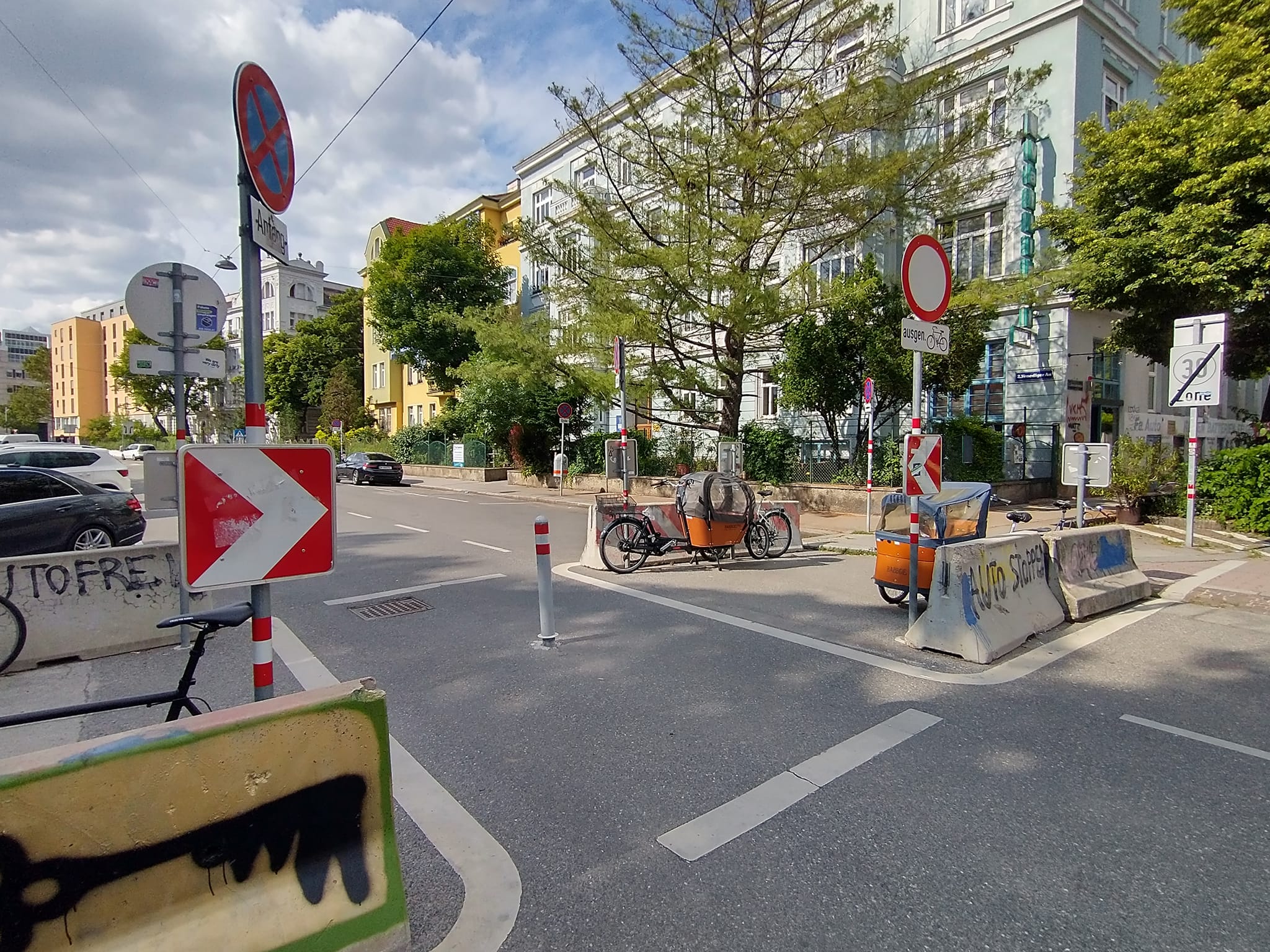Cycle Competence excursions showcase good practices

What do Leithaprodersdorf and Paris have in common? Only one thing: this summer, Cycle Competence Austria organised two excursions exploring the topic of cycle infrastructure. In June, the Mobility Academy ADMA from the French capital visited to explore good examples of urban cycling infrastructure in the Vienna region for a European learning program. They visited places such as Mödling, similar to our excursion in August, which we conducted for the municipal council from Burgenland.
Academie Mobilité en Autriche
The ADMA excursion had a packed schedule: in one week, they aimed to visit good examples of bicycle and pedestrian-friendly urban planning in Vienna, Lower Austria, Graz, Salzburg, and Vorarlberg. Cycle Competence members were available at all destinations for expert advice and guided bike tours, coordinated by the Cycle Competence office. Two days were spent in Vienna with visits and meetings, complemented by a visit to Mödling as an example of improvements in historic small towns.
The French delegation also visited an example of a traffic filter in Vienna’s Stuwerviertel neighbourhood.
Excursion from Burgenland to the Mödlingbach
The reason for organising this excursion was quite particular: the mayor of the municipality of Leithaprodersdorf had won the “Mayors Challenge” of the „Österreich radelt“ (“Austria cycles”) initiative, earning them a one-day expert cycling excursion in rural areas sponsored by the Federal Ministry for Climate Protection (BMK). The excursion was organised by the Cycle Competence office and was professionally supervised and guided by Michael Skoric of Cycle Competence member con.sens mobilitätsdesign. The municipalities selected to visit were Wiener Neudorf and Mödling. Both places have some interesting cycling solutions to showcase and are at a convenient cycling distance from Vienna for an excursion.
Wiener Neudorf is building bridges and cycle paths
In recent years, the market town of Wiener Neudorf has put a strong focus on redesigning streets and enhancing their appeal for active mobility. “Notable examples include the redesign of the main road with the construction of a pedestrian and cycling path, as well as the construction of a pedestrian and cycling bridge over the Mödlingbach,” highlights traffic planner Michael Skoric.
In Wiener Neudorf’s Hauptstraße (main road), the gradual redesign of the 1.3 km long main road with high-quality street space design, generous green areas, and a roadway narrowed to 6 meters was extensively visited. This allowed for the creation of space for trees and a comfortable mixed-use pedestrian and cycle path. Innovative informal colourings of the cycling lanes along the building facades are intended to encourage cyclists to ride closer to the road.
Additionally, the cycling group visited the new pedestrian and cycling bridge over the Mödlingbach, an important connection between the neighbourhoods, the attractive leisure cycling route along the Mödlingbach, and the current construction site for the construction of a new pedestrian and cycle path on the Schillerstraße. Around the church and the new Herzfelderhof on the B17, traffic-calmed areas including shared-use zones and pedestrian and cycle paths have been created.
Mödling is systematically expanding its cycling infrastructure
After a leisurely lunch at the local winery with lively discussions among the experts, the bike tour continued to Mödling’s town center. There, Michael Skoric highlighted the longstanding process of improvement in the town: “The municipality of Mödling recognised many decades ago that cycling is an ideal mode of transportation for the town due to its topography and population density. Therefore, Mödling has systematically advanced the expansion of cycling infrastructure in recent years. Building on a municipal cycling concept and the basic cycle network of Lower Austria, gaps in the cycling network are gradually being filled, new through-routes are being established, and existing infrastructure is being improved.”
The town with 20,000 inhabitants provides new thoroughfares in the north-south direction from Hyrtlplatz to the Mödlingbach and onwards via the new Stadionweg to the Schleussnerstraße. In 2019, a pedestrian and cycling path was constructed along Guntramsdorfer Straße, spanning 900 meters in length, as an important connection to the HTL (Higher Technical Institute). Mödling was the first town in Lower Austria to implement the “sponge city” principle during this project, directing surface water into green areas through neighbouring planting and landscaping.
In the urban development area around the former Gendarmerie Central School, hundreds of new apartments, a local shop, and a new kindergarten are set to be built. Pedestrian and cyclist thoroughfares were carefully considered during the planning phase, and the town of Mödling invited the public to participate in extensive consultation processes.
Both the French researchers and the Burgenland municipal council visited the cargo bike rental station in the center of Mödling, where the municipal government provides E-cargo bikes to residents free of charge. The radverteiler rental solution, using the smart rental point, which can be opened around the clock via a mobile phone, is provided by Cycle Competence member quadratic.
Municipalities or groups interested in tailor-made expert excursions with Cycle Competence Austria can contact our office directly at buero@radkompetenz.at
Cycling Competence Members in this article:
More articles with this member:
[crp]
Share this article:
Cycle Competence excursions showcase good practices
Share this article:

What do Leithaprodersdorf and Paris have in common? Only one thing: this summer, Cycle Competence Austria organised two excursions exploring the topic of cycle infrastructure. In June, the Mobility Academy ADMA from the French capital visited to explore good examples of urban cycling infrastructure in the Vienna region for a European learning program. They visited places such as Mödling, similar to our excursion in August, which we conducted for the municipal council from Burgenland.
Academie Mobilité en Autriche
The ADMA excursion had a packed schedule: in one week, they aimed to visit good examples of bicycle and pedestrian-friendly urban planning in Vienna, Lower Austria, Graz, Salzburg, and Vorarlberg. Cycle Competence members were available at all destinations for expert advice and guided bike tours, coordinated by the Cycle Competence office. Two days were spent in Vienna with visits and meetings, complemented by a visit to Mödling as an example of improvements in historic small towns.
The French delegation also visited an example of a traffic filter in Vienna’s Stuwerviertel neighbourhood.
Excursion from Burgenland to the Mödlingbach
The reason for organising this excursion was quite particular: the mayor of the municipality of Leithaprodersdorf had won the “Mayors Challenge” of the „Österreich radelt“ (“Austria cycles”) initiative, earning them a one-day expert cycling excursion in rural areas sponsored by the Federal Ministry for Climate Protection (BMK). The excursion was organised by the Cycle Competence office and was professionally supervised and guided by Michael Skoric of Cycle Competence member con.sens mobilitätsdesign. The municipalities selected to visit were Wiener Neudorf and Mödling. Both places have some interesting cycling solutions to showcase and are at a convenient cycling distance from Vienna for an excursion.
Wiener Neudorf is building bridges and cycle paths
In recent years, the market town of Wiener Neudorf has put a strong focus on redesigning streets and enhancing their appeal for active mobility. “Notable examples include the redesign of the main road with the construction of a pedestrian and cycling path, as well as the construction of a pedestrian and cycling bridge over the Mödlingbach,” highlights traffic planner Michael Skoric.
In Wiener Neudorf’s Hauptstraße (main road), the gradual redesign of the 1.3 km long main road with high-quality street space design, generous green areas, and a roadway narrowed to 6 meters was extensively visited. This allowed for the creation of space for trees and a comfortable mixed-use pedestrian and cycle path. Innovative informal colourings of the cycling lanes along the building facades are intended to encourage cyclists to ride closer to the road.
Additionally, the cycling group visited the new pedestrian and cycling bridge over the Mödlingbach, an important connection between the neighbourhoods, the attractive leisure cycling route along the Mödlingbach, and the current construction site for the construction of a new pedestrian and cycle path on the Schillerstraße. Around the church and the new Herzfelderhof on the B17, traffic-calmed areas including shared-use zones and pedestrian and cycle paths have been created.
Mödling is systematically expanding its cycling infrastructure
After a leisurely lunch at the local winery with lively discussions among the experts, the bike tour continued to Mödling’s town center. There, Michael Skoric highlighted the longstanding process of improvement in the town: “The municipality of Mödling recognised many decades ago that cycling is an ideal mode of transportation for the town due to its topography and population density. Therefore, Mödling has systematically advanced the expansion of cycling infrastructure in recent years. Building on a municipal cycling concept and the basic cycle network of Lower Austria, gaps in the cycling network are gradually being filled, new through-routes are being established, and existing infrastructure is being improved.”
The town with 20,000 inhabitants provides new thoroughfares in the north-south direction from Hyrtlplatz to the Mödlingbach and onwards via the new Stadionweg to the Schleussnerstraße. In 2019, a pedestrian and cycling path was constructed along Guntramsdorfer Straße, spanning 900 meters in length, as an important connection to the HTL (Higher Technical Institute). Mödling was the first town in Lower Austria to implement the “sponge city” principle during this project, directing surface water into green areas through neighbouring planting and landscaping.
In the urban development area around the former Gendarmerie Central School, hundreds of new apartments, a local shop, and a new kindergarten are set to be built. Pedestrian and cyclist thoroughfares were carefully considered during the planning phase, and the town of Mödling invited the public to participate in extensive consultation processes.
Both the French researchers and the Burgenland municipal council visited the cargo bike rental station in the center of Mödling, where the municipal government provides E-cargo bikes to residents free of charge. The radverteiler rental solution, using the smart rental point, which can be opened around the clock via a mobile phone, is provided by Cycle Competence member quadratic.
Municipalities or groups interested in tailor-made expert excursions with Cycle Competence Austria can contact our office directly at buero@radkompetenz.at
Cycling Competence Members in this article:
More articles with this member:
[crp]





